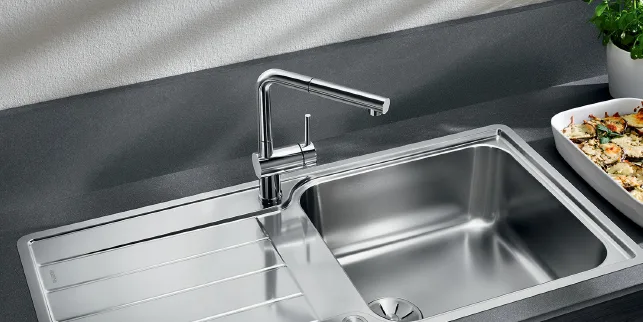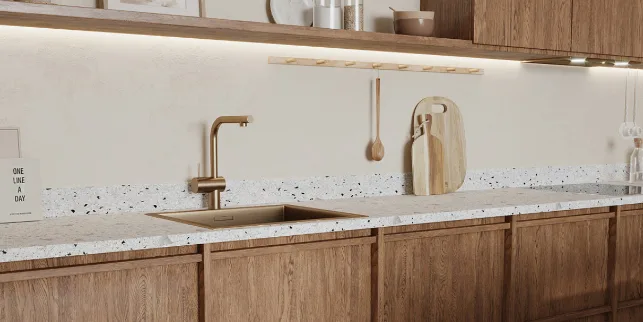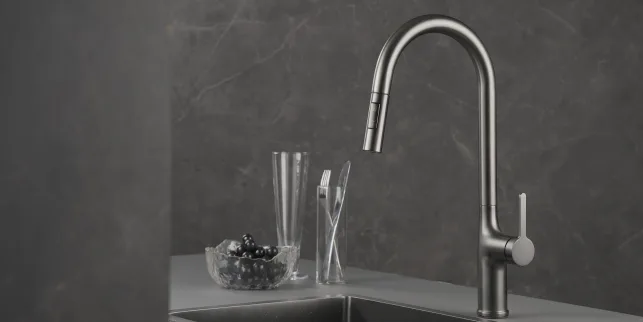Lead-Free Faucets: The New Standard in Kitchen Design
In the realm of modern kitchen design, lead free fixtures have emerged not just as a trend but as a necessary standard. This evolution reflects growing concerns about health and safety, particularly relating to lead in drinking water.
As the market adapts, faucet manufacturers are responding by crafting faucets that meet stringent safety regulations while also enhancing aesthetic appeal.
What are Lead Free Fixtures?

Lead free fixtures are plumbing fixtures designed to minimize exposure to lead. Lead has been identified as a hazardous contaminant that can impair human health, even at low levels. Traditionally, faucets contained lead as a part of materials and manufacturing processes because it makes brass more malleable.
However, the Safe Drinking Water Act and amendments have pushed manufacturers to adopt lead free solder and materials like stainless steel and solid brass that significantly lower the weighted average of lead content.
Why Choose Lead Free?
Opting for faucets free of lead is a crucial step towards ensuring the safety and purity of your home’s drinking water. Most people are aware that lead is harmful, especially to children, who are particularly vulnerable to its neurotoxic effects.
By installing lead free fixtures and components, you effectively minimize the risk of lead exposure, which can result from the corrosion of older plumbing systems.
Furthermore, using lead free materials in faucets and piping is a proactive compliance with health and safety standards, ensuring that your plumbing system upholds the highest quality of water for human consumption.
- Safety: Reducing lead exposure is vital, particularly in family homes where children are at greater risk.
- Water Quality: Guarantees that the tap water remains pure and safe for human consumption.
- Compliance: Meets both national and global safety norms, conforming to recent amendments to the drinking water act.
Impact on Health and Safety
The presence of lead in plumbing system components is a significant health hazard, contributing to a range of water-related issues. Utilizing lead-free plumbing fittings and faucets is crucial for mitigating this risk and ensuring that water quality remains safe for drinking and cooking.

Key Components:
Most faucets have the following key components:
- Materials: Implementing lead-free materials such as chrome, stainless steel, and ceramics is essential. These materials do not leach harmful contaminants into water, thus preserving its purity and safety.
- Design: Contemporary faucet designs focus on minimizing areas where water might stagnate, a common problem in older models. By reducing these areas, modern faucets help prevent the buildup of contaminants, ensuring cleaner water output.
- Innovative Features: Many modern faucets come equipped with features such as built-in filters and advanced water flow technologies. These innovations not only improve water quality but also enhance user convenience and hygiene by reducing the need to handle the faucet frequently.
Through these strategic choices in material and design, as well as the adoption of new technologies, modern faucets significantly reduce health risks associated with water contamination. This proactive approach in plumbing design plays a pivotal role in maintaining public health standards.
Technological Innovations in Faucet Design

Faucet companies are vigorously innovating to enhance not only the safety but also the functionality and aesthetic appeal of their products. Advanced features like touchless operation, which promotes hygiene by minimizing contact, and sophisticated water filtration systems that ensure purity and taste are now becoming more common in household faucets.
Key Innovations:
- Filtered Water: Many modern faucets now include integrated filters that remove nearly immeasurable amountsof impurities, providing cleaner and better-tasting water directly from the tap.
- Smart Features: Technological advancements have led to the development of smart faucets that offer features like water usage tracking and temperature control, all manageable via smartphone apps. These smart faucets can also be programmed to respond to voice commands and integrate seamlessly with home automation systems, offering both convenience and efficiency.
These innovations not only improve daily interactions with water fixtures but also contribute to a more sustainable and health-conscious living environment.
Standards and Regulations
Faucet companies are vigorously innovating to enhance not only the safety but also the functionality and aesthetic appeal of their products. Advanced features like touchless operation, which promotes hygiene by minimizing contact, and sophisticated water filtration systems that ensure purity and taste are now becoming more common in household faucets.

Key Innovations:
- Filtered Water: Many modern faucets now include integrated filters that remove nearly immeasurable amountsof impurities, providing cleaner and better-tasting water directly from the tap.
- Smart Features: Technological advancements have led to the development of smart faucets that offer features like water usage tracking and temperature control, all manageable via smartphone apps. These smart faucets can also be programmed to respond to voice commands and integrate seamlessly with home automation systems, offering both convenience and efficiency.
These innovations not only improve daily interactions with water fixtures but also contribute to a more sustainable and health-conscious living environment.
Standards and Regulations

The Safe Drinking Water Act has been a crucial piece of legislation in ensuring the safety of drinking water across the United States. This act, significantly strengthened by amendments President Obama signed, has established stringent controls over the allowable amount of lead in plumbing products, promoting the widespread adoption of lead-free spigots.
Key Regulatory Bodies
Adhering to regulatory bodies like NSF International and IAPMO is essential for several reasons. These organizations establish safety standards that ensure plumbing products, including faucets, do not compromise public health by exposing users to harmful contaminants like lead.
Their guidelines help manufacturers create products that are safe, reliable, and compliant with current health regulations. Compliance not only builds consumer trust but also shields manufacturers and consumers from legal and health repercussions associated with non-compliance.
In essence, the international association plays a critical role in maintaining the integrity and safety of drinking water systems.
- NSF International: This organization plays a vital role in setting public health and safety standards for water treatment and plumbing products. NSF certification is a gold standard, indicating that a product meets strict health and safety regulations.
- International Association of Plumbing and Mechanical Officials (IAPMO): This body focuses on developing codes and standards for the plumbing and mechanical industries to ensure public health, safety, and welfare. They are instrumental in setting performance criteria for plumbing systems, including those that involve lead-free components.
By adhering to both international and national standard and regulations, manufacturers and consumers contribute to a safer, healthier environment, significantly reducing the risks associated with lead exposure from drinking water systems.
Choosing the Right Lead-Free Faucet for Your Home

Selecting the right bathroom or kitchen sink faucet is crucial for both functionality and compliance with safety standards. When choosing a bathroom or kitchen faucet, it’s important to delve deeper than just the aesthetics and brand reputation; you need to consider the materials used, the safety features provided, and the overall quality.
Tips for Selection:
- Read Labels: Always check the product labels to ensure they confirm compliance with safety standards like the NSF International certifications or the Safe Drinking Water Act. These labels provide assurance that the faucet will not compromise your water quality.
- Consult Professionals: It’s advisable to talk with a plumber or a specialist in kitchen faucets or bathroom faucets. These experts can offer advice based on your existing plumbing setup and can recommend faucets that meet both your functional needs and safety requirements.
- Consider Aesthetics and Functionality: Make sure the faucet not only fits the style of your kitchen or bathroom but also offers the ergonomic functionality you need. For instance, features like spray heads for kitchen sinks or water-saving functions can add convenience while also being eco-friendly.
- Material Matters: Pay close attention to the materials used in the faucets. Options like solid brass offer durability and are often recommended for their resistance to corrosion and lead contamination.
- Future Proof Your Choice: Look for faucets that come with a warranty and are supported by good customer service. This ensures that your investment is protected and you have recourse in case of any defects or issues.
By taking these considerations into account, you can make a well-informed decision that ensures safety, efficiency, and style in your home’s water fixtures.
Looking Ahead: The Future of Faucets

The transition to lead-free fixtures is a key component of a larger shift toward sustainable and safe building materials. With ongoing advancements in legislation and growing consumer awareness, there is an increasing demand for these products, shaping the development of new faucets and plumbing fittings in the industry.
Future Trends:
- Eco-Friendly Materials: There is a trend towards using more recycled and eco-friendly materials in the production of faucets. This not only supports environmental sustainability but also appeals to the eco-conscious consumer.
- Smart Home Integration: Faucets are increasingly being integrated into smart home systems, allowing for enhanced resource management and user convenience. This includes features like automatic temperature control, usage tracking, and even water quality monitoring.
- Advanced Water Filtration: Newer faucets are expected to come equipped with sophisticated filtration technologies that provide cleaner and safer water directly from the tap.
These innovations are not just about meeting regulatory compliance; they represent a commitment to health and environmental stewardship within home design. As technology evolves, these advanced fixtures are poised to transform our interaction with water, prioritizing safety and sustainability at every turn.
Conclusion
As we advance toward safer and healthier living environments, the emphasis on faucets that conform to rigorous safety standards is more important than ever. Opting for stainless steel and brass faucets from companies like Infaucets.com not only enhances water quality but also supports adherence to the Safe Drinking Water Act.
Infaucets.com‘s commitment to defined plumbing fixtures and superior quality helps ensure that consumers reduce health risks and support sustainable practices. This focus on safety, innovation, and quality is vital for maintaining the integrity of our drinking water systems.
Frequently Asked Questions About Faucets and Water Safety
Check this FAQ if you have further questions about faucets free of lead:
Consuming drinking water with lead can lead to significant health problems, particularly for vulnerable populations like children, who may suffer developmental issues as a result. Using fixtures with lower lead content helps mitigate these health risks. It is critical to install faucets that comply with the latest safety standards to ensure that water quality is maintained at a safe level.
The Safe Drinking Water Act has prompted faucet manufacturers to innovate and redesign kitchen or bathroom faucets to comply with stringent lead content regulations. This legislation affects the availability of faucets on the market, ensuring that only products meeting safety requirements are available to consumers, thereby enhancing water quality and consumer safety.
Stainless steel and brass are preferred materials for faucets because they do not corrode easily and maintain water quality over time. These materials help in reducing lead contamination and are often featured in high quality faucets due to their durability and aesthetic appeal. Consumers should look for faucets made from these materials to ensure longevity and safety in their drinking water systems.
Defined plumbing fixtures are essential for a safe water supply system as they are designed to prevent leaks and reduce the risk of contamination. These fixtures are engineered according to national standards to ensure that they do not adversely affect water quality. Ensuring that your home uses these well-regulated fixtures is key to maintaining safe and clean drinking water.
The weighted average of lead content in faucets indicates the overall exposure to lead that consumers might face. By choosing kitchen or bathroom faucets with a lower average weight of lead, homeowners can significantly reduce the risk of lead exposure, adhering to health guidelines and safeguarding family health. This consideration is especially important in regions with aging infrastructure where lead risks are higher.
When selecting kitchen faucets, consumers should look for features that comply with new legislation, which typically mandates lower lead content. Modern faucets should have innovative designs that incorporate advanced manufacturing processes to reduce lead exposure. Additionally, certifications like those from NSF International provide assurances that bathroom or kitchen faucets meet stringent safety standards.

